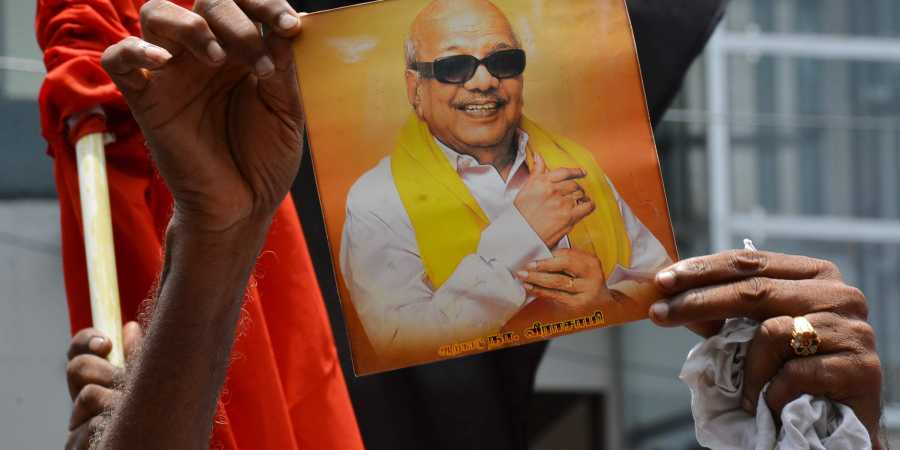The political landscape of India has in one voice expressed condolences over the demise of political heavyweight and DMK veteran, Karunanidhi. The 94-year old politician had a very influential role to play in Tamil Nadu politics. He became chief minister of the southern state five times and won 12 state elections, building his support base with every win. We, therefore present you with a description of the nonagenarian’s life journey.
Karunanidhi’s birth name was Dakshinamurthy. His birth place was Thirukkuvalai village in Tamil Nadu’s Nagapattinam district. He entered the political arena at the age of merely 14 years and got immediately influenced by the Dradvidian ideology even as he became a student activist in EV Ramasamy or ‘Periyar’s’ Self-Respect Movement. Karunanidhi remained a staunch Dravidian throughout his life.
Karunanidhi also tried his hand at theatre and the film industry. In the 1940s, Karunanidhi got into writing plays for theatre groups. He also became the editor of ‘Kudi Arasu’, a Tamil weekly magazine that was published by Naicker. In 1942, Karunanidhi circulated his own 8-page handwritten newspaper, Manavar Nesan that later on became the DMK mouthpiece. However, it was only in 1944 that he joined Jupiter Pictures as a screenwriter. In 1947, Rajkumari, was the first film he scripted that was released. In 1952, he wrote series of scripts based on the idea of Dravidian uprising and the most famous of the series was Parasakthi starring Sivaji Ganesan.
Karunanidhi’s active political career started in 1949 when he joined DMK founded by CN Annadurai. Following India’s independence, this party was floated inspired by Naicker’s Dravidian ideology. He made his first mark on Indian politics in 1953 with the Kallakudi agitation in 1953. When the New Delhi headquartered Dalmia Cements set up a plant in Kallakudi, Trichy and renamed the town to Dalmiapuram, Karunanidhi and other DMK leaders laid themselves over railway tracks protesting the name change of the station. He was jailed for three months.
He first tasted success in 1957 at the age of 33 years he won the Kulithalai (Karur district) seat in the state assembly elections. Further, in 1961 Karunanidhi was appointed treasurer of the DMK and in 1962, he was appointed as the deputy leader of opposition in the state assembly. After his mentor Annadurai passed away in 1969, he became the chief minister of Tamil Nadu and the first leader of DMK.
In 1972, MG Ramchandran left the DMK and went on to launch his own party AIADMK. Indira Gandhi dismissed the DMK government in 1976 creating further crisis for the party. Karunanidhi however, finally came back to power in 1989 two years after Ramchandran’s death. However, it was dismissed in 1991 on account of LTTE connections. In 1996, Karunanidhi managed to bring the DMK government back to power after Jayalalitha faced corruption charges.
Facing setbacks one after the other, the veteran made his final come back in 2006 when he led the DMK to victory with a manifesto making massive poll promises. His party could not come back to power in 2011 but Karunanidhi maintained political influence till his poor health crippled him from remaining active.
He also had a crucial role to play in coalition politics. He was involved in choice of Deve Gowda and IK Gujral for prime ministers, in 1996 and 1997 as a part of the Janata Dal (United Front) government. Later on, DMK had great influence on the UPA government and in fact, DMK very often led UPA government to crisis with scandals from time to time.
